Does your desk feel like a tornado hit it? Stacks of papers, tangled cords, and forgotten coffee mugs can turn even the coziest workspace into a stress zone. Studies show that visual chaos reduces focus by up to 20%, making it harder to tackle tasks efficiently. But here’s the good news: small, intentional changes can transform your environment—and your mindset.
I used to work at a desk buried under old notes and mismatched supplies. Every search for a pen felt like a treasure hunt! Over time, I realized that physical mess creates mental fog. Research supports this: cluttered spaces directly impact decision-making and creativity. That’s why simplifying isn’t just about aesthetics—it’s about reclaiming your productivity.
This guide walks you through practical steps to refresh your work area. Whether you’re dealing with a crowded shelf or a drawer full of mystery items, we’ll break it down into bite-sized actions. Did you know 75% of office supplies can be recycled or repurposed? Start with one corner using these strategies, and watch progress unfold.
Remember, consistency beats perfection. Spending five minutes daily to sort papers or label bins adds up. Soon, you’ll have a space that fuels focus instead of frustration. Ready to trade overwhelm for clarity? Let’s begin.
Why a Clutter-Free Home Office Matters
Clutter isn’t just messy—it’s a productivity thief. When every surface is covered with loose papers or scattered pens, you waste precious minutes hunting for things. Studies reveal workers spend nearly 1.5 hours daily searching for misplaced items. Imagine reclaiming that time for meaningful tasks instead!
Boosting Productivity and Focus
An organized desk acts like a roadmap for your day. Labeled folders, sorted supplies, and a designated spot for essentials like pens cut decision fatigue. This creates mental space for deeper focus. Think of it this way: fewer distractions mean faster progress on projects.
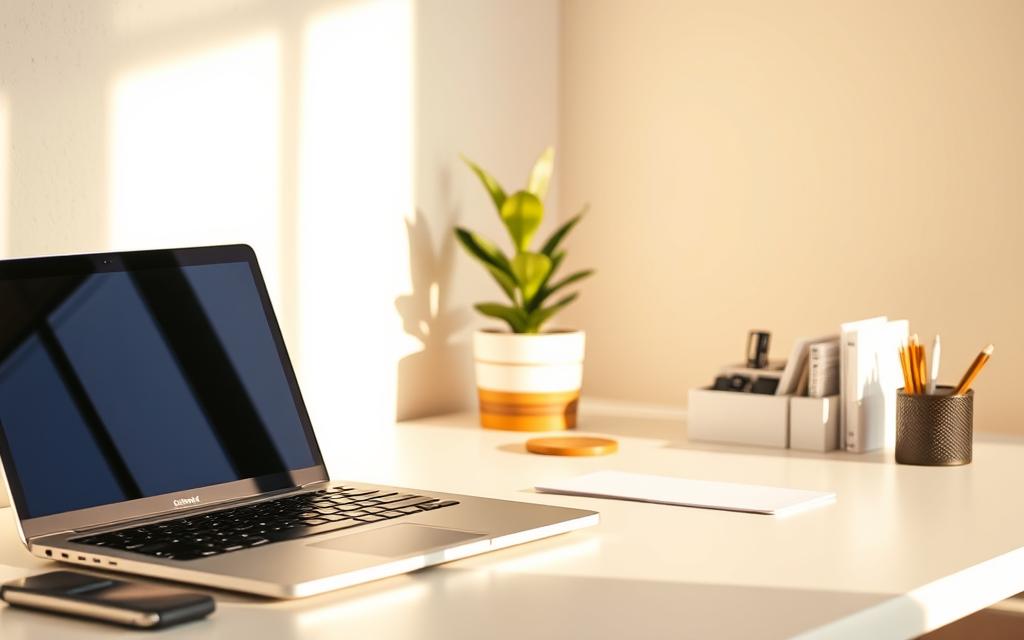
Enhancing Mental Clarity and Professionalism
A tidy environment does more than save time—it lowers stress. When your workspace feels calm, creativity flows easier. Plus, clients notice. A polished area reflects reliability, whether you’re on video calls or hosting meetings. Small wins matter: storing cables or recycling old notes paves the way for lasting habits.
Want to amplify these benefits? Pair your physical organization with positive affirmations to reinforce a productive mindset. Consistency turns these changes into second nature, transforming not just your desk—but your entire workday.
Getting Started with Quick Wins
Starting fresh can be as simple as tackling what’s in plain sight. When facing a messy area, focus on visible items first. These small tasks create instant momentum—like pressing a reset button for your workflow. Research shows that completing easy wins boosts confidence, making larger projects feel less intimidating.
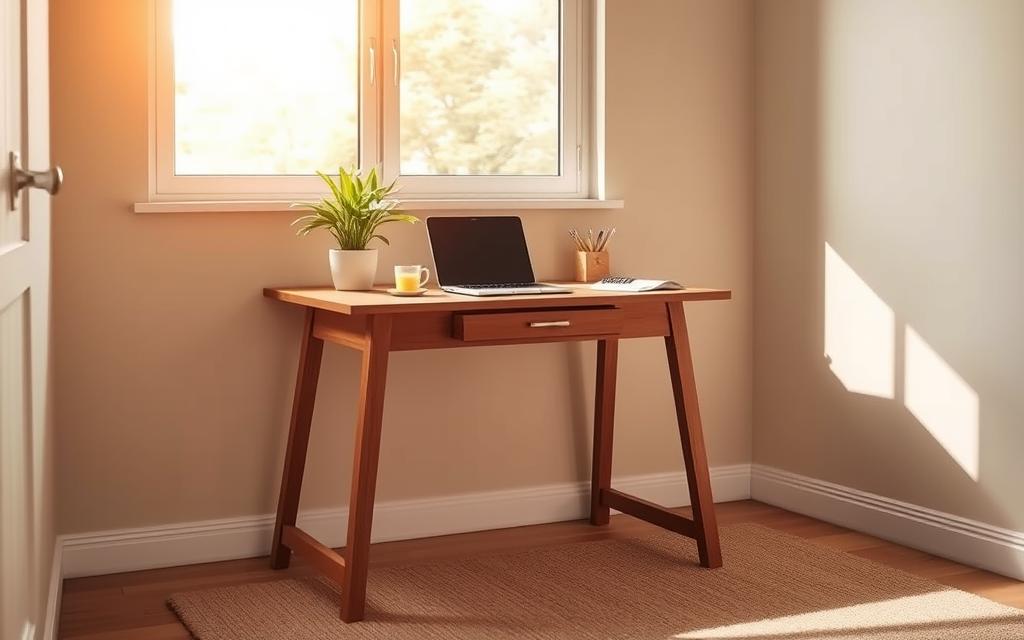
Removing Surface-Level Trash
Empty coffee cups, outdated sticky notes, or broken pens? Toss them! Clearing these items takes minutes but offers immediate visual relief. Sort through loose papers next: recycle duplicates and file essentials. This step alone can get rid of 30% of desk clutter. Keep things simple by using a trash bin and a “to sort” tray nearby.
Celebrating Small Accomplishments
Did you clear a drawer or organize cables? Acknowledge it! Quick wins aren’t just about tidiness—they rewire your brain to associate progress with satisfaction. Try these tips: snap a “before and after” photo or reward yourself with a fresh plant for your desk. These tiny celebrations keep things motivating, even when bigger tasks seem like mountains later.
Remember, the goal isn’t perfection. Spend 10 minutes daily applying these tips, and you’ll build habits that stick. Each cleared surface becomes a stepping stone toward a workspace that works for you, not against you.
Decluttering a Home Office: Step-by-Step Guide
Does stepping into your workspace feel like walking into a puzzle? Before diving in, take a breath. A clear plan turns chaos into progress. Start by surveying your environment—every shelf, drawer, and corner. This isn’t about judgment; it’s about awareness.
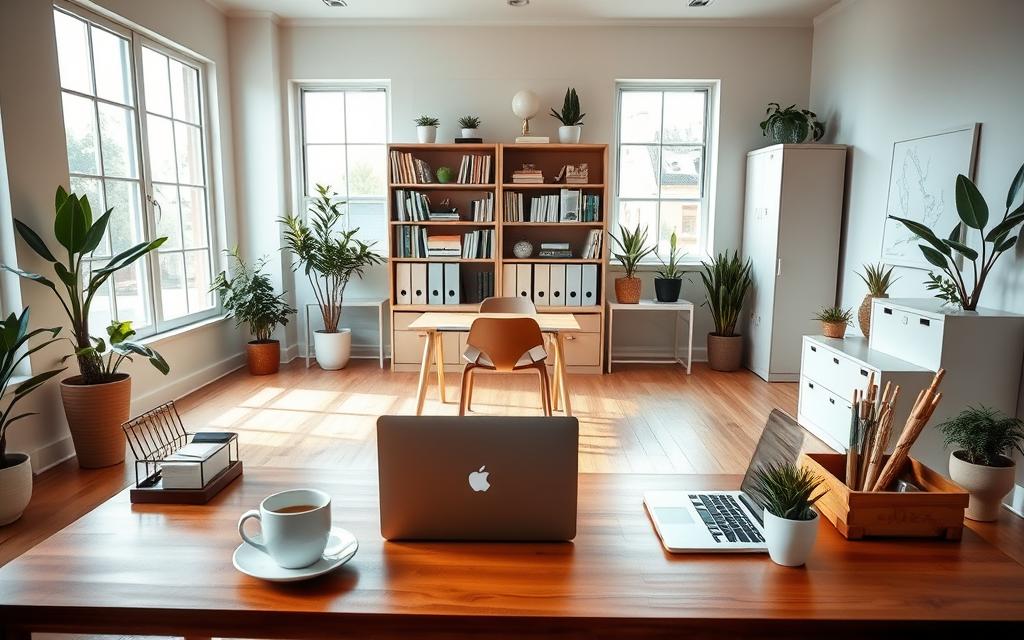
Surveying and Brain Dumping Your Space
Grab a notebook and list every cluttered spot. That overstuffed drawer? The pile of papers near your laptop? Write it all down. This “brain dump” helps you see patterns. Maybe your desk space needs urgent help, while storage areas can wait. Pro tip: Rank tasks from “urgent” to “later” using sticky notes.
Creating a Decluttering Checklist
Break your list into bite-sized steps. For example:
- Clear desk surface (15 minutes)
- Sort cables (10 minutes)
- Review items to throw away or donate (20 minutes)
Focus on one zone at a time. Tackling your entire office space at once may seem efficient, but it often leads to burnout. Instead, celebrate finishing a single task before moving on. Tools like digital checklists or apps can track progress without paper clutter.
Struggling to start? Try this step-by-step method designed for overwhelmed spaces. Remember, a detailed plan isn’t restrictive—it’s your roadmap to a workspace that finally works for you.
Optimizing Desk Space and Organization
Ever opened a drawer and found a jungle of cables? Transforming chaos into order starts with smart strategies for papers, supplies, and storage. A well-planned system turns frantic searches into quick grabs—saving time and sanity.
Sorting Papers and Office Supplies
Start by sorting papers into three piles: trash, action items, and archives. Shred outdated documents and file essentials in labeled folders. For daily items like sticky notes or pens, assign a dedicated tray. Professional organizers recommend a “one-touch rule”—handle each paper once before deciding its fate.
Store archived materials in clear bins under your desk. This keeps them accessible but out of sight. Weekly reviews prevent buildup. Bonus tip: color-code folders for projects to boost productivity at a glance.
Managing Cables, Drawers, and Boxes
Tangled cords? Use Velcro straps or adhesive clips to group cables by device. Label each with washi tape for quick identification. For drawers, install dividers to separate chargers from thumb drives. Store rarely used items in boxes with bold labels like “Tech Accessories” or “Backup Supplies.”
Empty one drawer at a time. Toss broken items and donate duplicates. Experts suggest keeping a small trash bin nearby during cleanup sessions. This simple habit stops clutter from creeping back.
An organized desk isn’t just pretty—it’s a productivity powerhouse. With everything in its place, you’ll spend less time digging and more time crushing goals.
Breaking Down Tasks for Daily Progress
Ever feel like your to-do list is a mountain? Chipping away at clutter doesn’t require marathon sessions. Instead, think of it as a series of tiny hikes. Fifteen-minute bursts of effort can reshape your environment without draining your energy. Here’s how to turn “I’ll do it later” into “Done!”
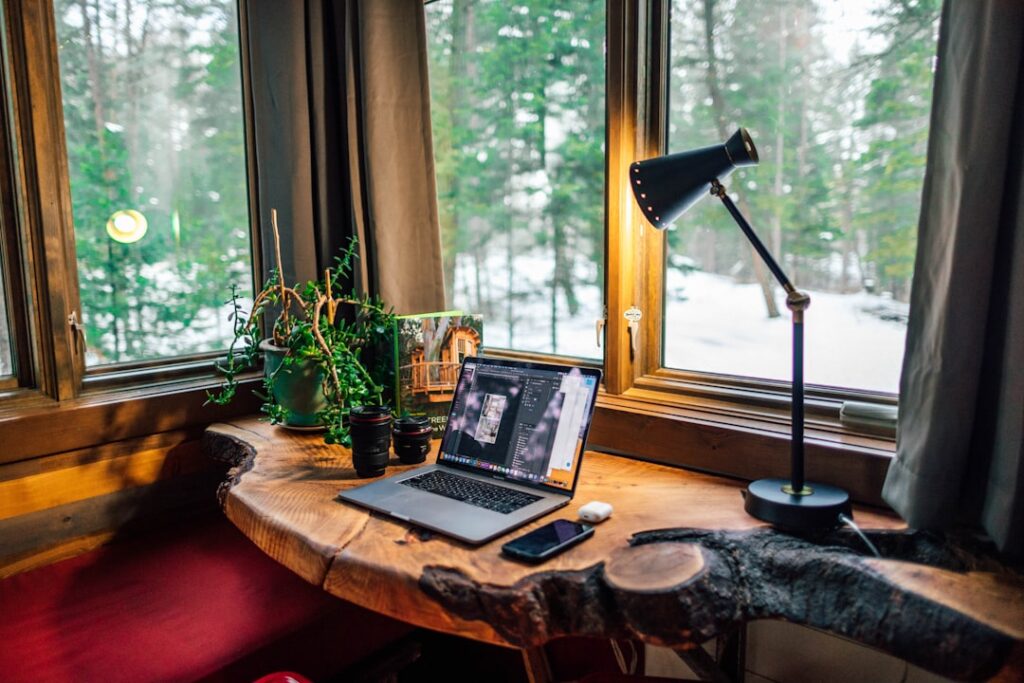
Setting Up 15-Minute Decluttering Sessions
Set a timer and focus on one spot: a single drawer, a pile of papers, or a shelf. Short bursts prevent burnout while building momentum. Research shows brief, focused efforts boost motivation by 40% compared to lengthy tasks. Tackle a box of old cables today, sort tomorrow’s stack of folders—progress adds up fast.
Strategic planning matters. Assign each session to specific zones: Monday for drawers, Wednesday for boxes under the desk. Label a “keep” bin and a “donate” bag to speed decisions. Even five minutes spent recycling expired coupons or wiping dust off shelves counts as forward motion.
Consistency turns these sprints into habits. Over time, you’ll notice fewer jammed drawers and clearer surfaces. Your workspace becomes a reflection of focused work, not frustration. Remember: small daily wins build lasting change.
Utilizing Tools and Systems for Organization
Smart tools turn chaos into order—no magic required. The right systems help you maintain progress without constant effort. Let’s explore how to pair physical solutions with digital upgrades for lasting results.
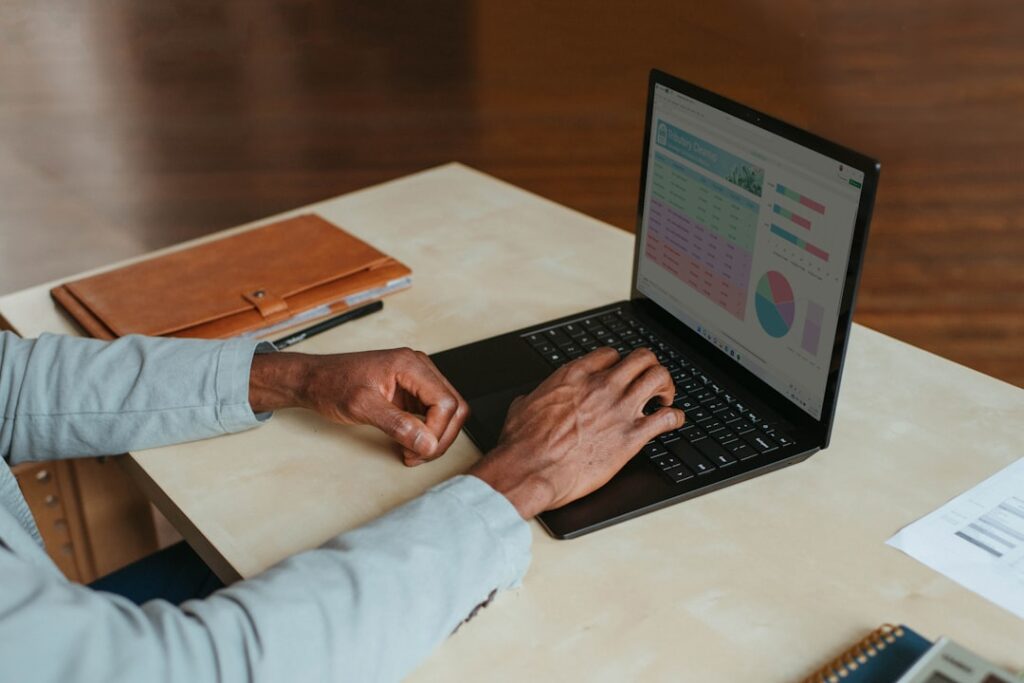
Implementing Storage Solutions and Dividers
Start by tackling those stubborn piles of supplies. Adjustable drawer dividers create custom slots for sticky notes, paper clips, or your favorite pen. Vertical shelves maximize wall space for books or decorative bins. Label everything! Clear containers let you spot items instantly, while stackable boxes keep rarely used materials tidy.
Try these steps:
- Sort items by frequency of use
- Assign a specific place for daily essentials
- Use tiered trays to handle multi-level storage needs
A dedicated pen holder near your keyboard stops desk scavenger hunts. For cables, try color-coded wraps. These small tweaks make declutter efforts stick.
Digitizing Documents and Notes
Reduce paper piles by scanning receipts and notes with apps like Adobe Scan. Store files in cloud folders labeled by project or date. This step cuts physical clutter while making info accessible from any device.
Keep a shredder nearby for sensitive documents. For quick access, use a desktop organizer for active files—everything else goes digital. Sync your digital system with physical storage: link cloud folders to labeled binders on shelves.
Combining tech with hands-on tools creates a level of efficiency that sustains momentum. Your workspace stays clean, and your mind stays sharp.
Progress Over Perfection: Building Lasting Habits
Maintaining order isn’t about grand gestures but daily habits. Consistency turns fleeting wins into permanent results. Research shows that five-minute daily check-ins reduce clutter relapse by 60% compared to weekly deep cleans. Think of it like brushing your teeth—small, non-negotiable moments keep chaos at bay.
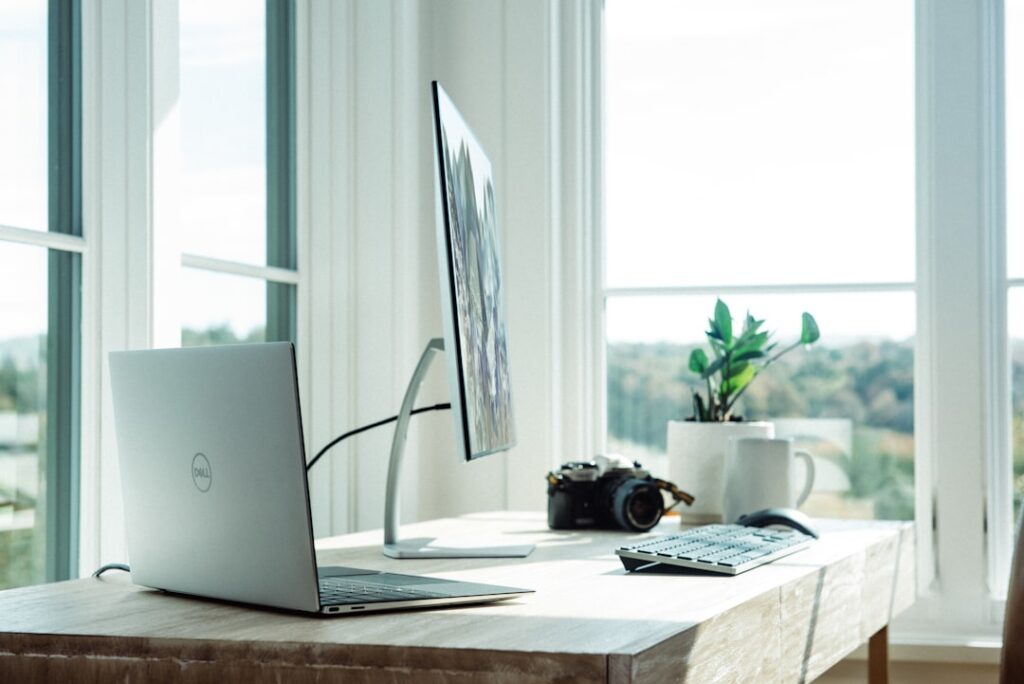
Establishing a Daily Cleanup Routine
Start by resetting your desktop and floor before logging off. Return pens to holders, file loose papers, and tuck cables out of sight. This ritual creates a fresh start for tomorrow. Keep a “quick fix” basket nearby for items needing relocation—empty it weekly to maintain flow.
Try these steps to lock in progress:
- Label two bins: “Frequent access” (daily tools) and “Archive” (rarely used supplies)
- Scan or photograph information-dense papers to reduce physical piles
- Wipe surfaces nightly—dust-free spaces boost focus
Perfectionists often stall waiting for ideal conditions. Instead, celebrate a drawer that stays tidy three days straight. Missed a day? No guilt—just reset. Over time, these micro-habits rewire how you interact with your workspace.
An organized floor and desk minimize distractions, letting creativity thrive. Store reference materials in labeled binders for easy access. Digital tools like cloud folders keep information at your fingertips without crowding your physical zone.
Remember: habits outlast motivation. Pair your cleanup routine with upbeat music or a post-task coffee. These small joys make maintenance feel less like work—and more like self-care for your productivity.
Conclusion
Transforming your workspace starts with recognizing that progress thrives on a basis of intentional action. By sorting items, implementing storage systems, and dedicating minutes daily to maintenance, you create a foundation for lasting change. Remember: eliminating junk isn’t a one-time event—it’s a habit that sharpens focus and fuels momentum.
Each strategy discussed—like digitizing papers or using vertical organizers—works best when paired with consistency. Small efforts compound, whether you’re clearing a single drawer or labeling cables. Over time, these steps reduce stress and amplify productivity, turning chaos into clarity.
Ready to begin? Start today with this step-by-step method designed for real-world results. Keep a donate bin nearby and revisit your systems monthly to stay ahead of clutter. Every choice to prioritize order strengthens your basis for success.
Your workspace reflects how you work. By tackling junk and embracing practical routines, you’ll craft an environment that supports—not stifles—your goals. Now’s the time to build a space where efficiency meets inspiration.
